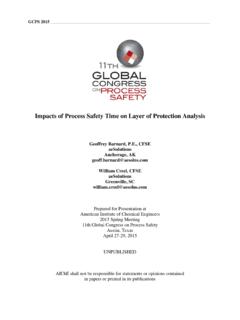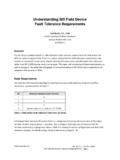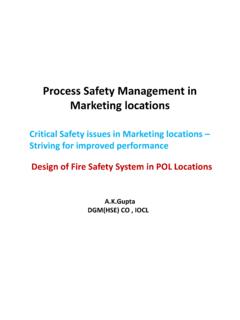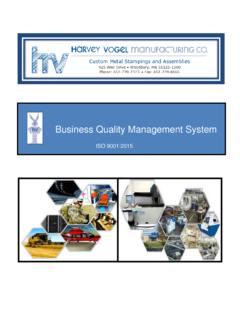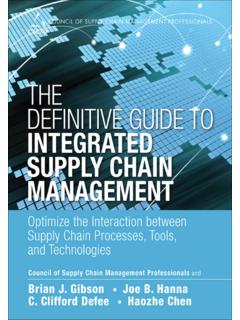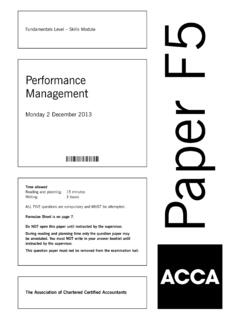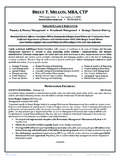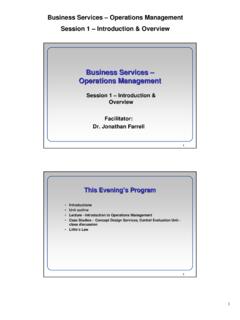Transcription of Codes and Standards Update: Safety Instrumented …
1 2016 aeSolutions Scott & FarnabyTAMU Instrumentation SymposiumJan 28, 2016 Page 1 Codes and Standards update : Safety Instrumented burner management Systems (Note: This paper was presented at the 2016 Texas A&M University Instrumentation Symposium for the Process Industries.) Ged Farnaby Director Business Development & Marketing aeSolutions Michael Scott, , CFSE Exec VP Global Process Safety Technology aeSolutions Keywords burner management Systems, BMS, Safety Instrumented System, SIS, Safety Instrumented burner management Systems, SI BMS, Safety Integrity Level, SIL, Safety Lifecycle, ANSI/ISA S84, IEC61511, Nation Fire Protection Association, NFPA Abstract Invoking the concept of a Safety Instrumented burner management System in all three of the NFPA 85, 86 and 87 series of Codes / Standards is a significant milestone for industry.
2 In 2002 when the ISA S84 committee first began developing the Technical Report, Guidance on the Identification of Safety Instrumented Functions (SIF) in burner management Systems (BMS), none of these Codes / Standards recognized the concept of a Safety Instrumented System. This issue directly contributed to schedule delays in the development process, which ultimately resulted in pushing the final publication of the Technical Report out to December of 2009. However, recently all three of the NFPA Codes / Standards that govern fired device burner management Systems (BMSs) have been updated to invoke the concept of Safety Instrumented Systems (SIS). These include the following: 1. NFPA 85 Boiler and Combustion Systems Hazard Code 2015 Edition 2. NFPA 86 Standards for Ovens and Furnaces 2015 Edition 3. NFPA 87 Recommended Practice for Fluid Heaters 2015 Edition This paper will highlight changes to the above Codes / Standards as they apply to the concepts of Safety Instrumented Systems.
3 This will include a discussion on equivalency clauses and / or linking paragraphs to ISA 2004 (IEC 61511 Mod) possibly allowing deviation from prescriptive requirements. Also of significant note is the modification of logic solver requirements with inclusion of a direct reference mandating the use of Safety PLCs with minimum SIL capabilities in certain instances. In addition, changes related to sensors and valve requirements will be highlighted. This 2016 aeSolutions Scott & FarnabyTAMU Instrumentation SymposiumJan 28, 2016 Page 2 paper will also highlight areas where the concepts of Safety Instrumented Systems in the author s opinion have been potentially misapplied within the NPFA series. Background NFPA 85, Boiler and Combustion Systems Hazards Code, applies to the following: (1) Single burner boilers, multiple burner boilers, stokers, and atmospheric fluidized bed boilers with a fuel input rating of MWt ( million Btu/hr) or greater (2) Pulverized fuel systems at any heat input rate (3) Fired or unfired steam generators used to recover heat from combustion turbines [heat recovery steam generators (HRSGs)] and other combustion turbine exhaust systems at any heat input rate NFPA 86, Standard for Ovens and Furnaces, applies to the following.
4 Shall apply to Class A, Class B, Class C, and Class D ovens, dryers, and furnaces; thermal oxidizers; and any other heated enclosure used for processing of materials and related equipment. NFPA 87, Recommended Practice for Fluid Heaters, applies to the following: ..covers Type F, Type G, and Type H fluid heaters and related equipment. Within the scope of this recommended practice, a fluid heater is considered to be any thermal fluid heater or process fluid heater with the following features: (1) Fluid is flowing under pressure. (2) Fluid is indirectly heated. (3) Release of energy from combustion of a liquid or gaseous fuel or an electrical source occurs within the unit. As one can see from the above, NFPA 85, 86 and 87 cover a wide variety of fired devices used in the process industry today. In North America, use of these Standards is very prevalent.
5 As such, it is imperative that they provide sound and consistent guidance when invoking SIS concepts to a BMS unit operation. Performance versus Prescriptive Per NFPA, Performance based Codes and Standards specifically state their Safety goals, and reference approved methods that can be used to demonstrate compliance with their requirements. The document may be phrased as a method for quantifying equivalencies to an existing prescriptive based code or standard, or it may identify one or more prescriptive Codes or Standards as approved solutions. Either way, the document allows the use of any solution that demonstrates compliance. The last sentence is extremely important in that a truly performance based code / standard does not mandate a specific design solution ( install a pressure switch at this location and close 1oo2 valves 2016 aeSolutions Scott & FarnabyTAMU Instrumentation SymposiumJan 28, 2016 Page 3 in the fuel gas piping) instead it allows the user to evaluate options for mitigating risk and choosing the best solution per their requirements.
6 ANSI / ISA / IEC61511: Functional Safety Safety Instrumented Systems for the Process Industry Sector invokes a performance based approach to managing risks to personnel and / or the environment through adoption of the Safety lifecycle. Simplistically, the Safety lifecycle embodies a three step methodology of overall risk management , which can be summarized as follows: 1. Execute Safety lifecycle documentation 2. Monitor leading/lagging process Safety indicators 3. Sustain safe unit operations through corrective actions Thus, using burner management Systems as an example, ANSI / ISA / IEC61511 does not provide specific guidance on BMS related hazards and / or the best way(s) to design a BMS to safely and efficiently design, install and maintain instrumentation / controls to prevent uncontrolled combustion events that could be hazardous to personnel and / or the environment.
7 It allows the use of any solution that demonstrates compliance to the standard. NFPA 85, 86 and 87 on the other hand are generally prescriptive in nature in that they provide specific requirements on BMS designs. This includes requirements related to specific BMS related hazards: Sensor types and installation locations Main burner block valve and vent valve locations Pilot burner block valve and vent valve locations / sizing Testing frequency Logic solver requirements Etc. Many of these requirements noted above have been added over the years in response to actual BMS hazardous incidents. NFPA 85 for instance can trace its roots back to NBFU 60, Regulations of the National Board of Fire Underwriters for the Installation of Pulverized Fuel Systems as Recommended by the National Fire Protection Association, which was initially published in 1924.
8 As hazardous incidents related BMS incidents occurred in industry, design recommendations based upon these events were added to the NFPA body of work. One should note however that NFPA 85 for instance states It is not possible for this code to encompass all specific hardware applications, nor should this code be considered a cookbook for the design of a Safety system. In applying any type of equipment to a Safety system, the designer should consider carefully all the possible failure modes and the effect that each might have on the integrity of the system and the Safety of the unit and personnel. As of the 2015 editions of NFPA 85, 86 and 87 all three now include direct references to ANSI / ISA / IEC61511: Functional Safety Safety Instrumented Systems for the Process Industry Sector. However, in many instances the references related to SISs have been done so in a prescriptive manner, which is directly in conflict with the originating performance based requirements of the 2016 aeSolutions Scott & FarnabyTAMU Instrumentation SymposiumJan 28, 2016 Page 4 Safety lifecycle.
9 In some instances, it is the author s opinion that these misapplied SIS concepts could be potentially unsafe and / or increase cost of ownership. Equivalency Statements The 2015 editions of NFPA 85, 86, and 87 now all contain language that allows one to apply the performance based design concepts of ANSI / ISA / IEC61511. Specifics for each standard are noted below: NFPA 85 NFPA 85, Boiler and Combustion Systems Hazards Code, invokes the Safety lifecycle through the equivalency clause in Section which states: Equivalency. Nothing in this code is intended to prevent the use of systems, methods, or devices of equivalent or superior quality, strength, fire resistance, effectiveness, durability, and Safety over those prescribed by this code. Section defines prescriptive requirements for the burner management System Logic. NFPA 85 Annex A provides additional explanatory material.
10 Annex A is not a part of the requirements of this NFPA document but is included for informational purposes only. This annex contains explanatory material, numbered to correspond with the applicable text paragraphs. Utilizing the equivalency provision in Section , an alternative design to meet the requirements of the code can be accomplished where all the following are provided: (1) Approval of the authority having jurisdiction. (2) A documented hazard analysis that addresses all the requirements of this code. (3) A documented life cycle system Safety analysis that addresses all requirements of this code and incorporates the appropriate application based Safety integrity level (SIL) for Safety Instrumented systems (SIS). One methodology for achieving a life cycle system Safety analysis is to use a process that includes SIL determination and a SIS design and implementation consistent with the ANSI/ISA , Application of Safety Instrumented Systems for the Process Industry, or IEC 61511, Functional Safety Safety Instrumented Systems for the Process Industry Sector.
